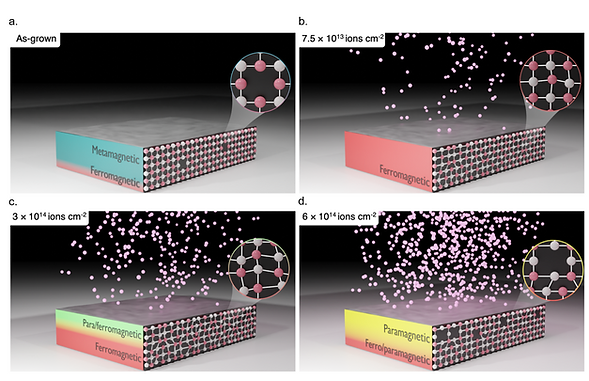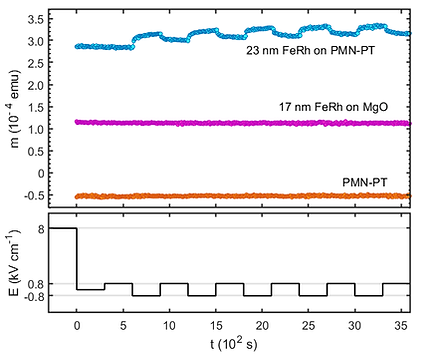PUBLICATIONS
Encoding and multiplexing information signals in magnetic multilayers with fractional skyrmion tubes
R. Chen, Y. Li, W. Griggs, Y. Zhang, V. F. Pavlidis, and C. Moutafis. "Encoding and multiplexing information signals in magnetic multilayers with fractional skyrmion tubes", ACS Applied Materials and Interfaces 15, 34145-34158 (2023).
Tailored magnetic multilayers (MMLs) provide skyrmions with enhanced thermal stability, leading to the possibility of skyrmion-based devices for room-temperature applications. At the same time, the search for additional stable topological spin textures has been under intense research focus. Besides their fundamental importance, such textures may expand the information encoding capability of spintronic devices. However, fractional spin texture states within MMLs in the vertical dimension are yet to be investigated. In this work, we demonstrate numerically fractional skyrmion tubes (FSTs) in a tailored MML system. We subsequently propose to encode sequences of information signals with FSTs as information bits in a tailored MML device. Micromagnetic simulations and theoretical calculations are used to verify the feasibility of hosting distinct FST states within a single device, and their thermal stability is investigated. A multilayer multiplexing device is proposed, where multiple sequences of the information signals can be encoded and transmitted based on the nucleation and propagation of packets of FSTs. Finally, pipelined information transmission and automatic demultiplexing are demonstrated by exploiting the skyrmion Hall effect and introducing voltage-controlled synchronizers and width-based track selectors. The findings indicate that FSTs can be potential candidates as information carriers for future spintronic applications.

Depth selective magnetic phase coexistence in FeRh thin films
W. Griggs, B. Eggert, M. O. Liedke, M. Butterling, A. Wagner, U. Kentsch, E. Hirschmann, M. Grimes, A. J. Caruana, C. Kinane, H. Wende, R. Bali, and T. Thomson. "Depth selective magnetic phase coexistence in FeRh thin films", APL Materials 8,121103 (2020).
We demonstrate the manipulation of magnetic phases in FeRh thin films through atomic displacements and the distribution of structural defects. Atomic scale disorder can be controlled via irradiation with light noble gas ions, producing depth-varying nanoscale phase configurations of distinct antiferromagnetic, ferromagnetic, and paramagnetic regions. Here, we perform a spatial characterization of the magnetic phases and the local magnetic environment around the Fe atoms, as well as the variation of the open-volumes around atomic sites. Thus, a direct correspondence between the existence of the three magnetic phases and lattice defects is revealed. By careful selection of the irradiating fluence, we show that it is possible to produce simple and thermally stable magnetic configurations, such as uniform magnetization or a bilayer phase structure. Furthermore, the thin film surface and interfaces are observed as the nucleation sites for the transitions between the phases. These results demonstrate a sensitive nanoscale manipulation of magnetic properties, shedding light on magnetic ordering in alloy lattices and broadening the scope for applications.

Repeatable and deterministic all electrical switching in a mixed phase artificial multiferroic
W. Griggs and T. Thomson. "Repeatable and deterministic all electrical switching in a mixed phase artificial multiferroic", Scientific Reports 12, 5332 (2022).
We demonstrate a repeatable all-electric magnetic switching behaviour in a PMN-PT/FeRh thin film artificial multiferroic. The magnitude of the effect is significantly smaller than expected from conventional thermomagnetic switching of FeRh thin films and we explore properties of the PMN-PT/FeRh system in order to understand the origin of this reduction. The data demonstrate the importance of the crystallographic phase of PMN-PT and show how a phase transition at ~ 100 °C modifies the magneto-electric coupling. We demonstrate a large strain remanence effect in the PMN-PT substrate, which limits the magnetoelectric coupling on successive cycling of the applied electric field.

Polarized neutron reflectometry characterization of interfacial magnetism in an FePt/FeRh exchange spring
W. Griggs, C. Bull, C. W. Barton, R. Griffiths, A. Caruana, C. J. Kinane, P. W. Nutter, and T. Thomson. "Polarized neutron reflectometry characterization of interfacial magnetism in an FePt/FeRh exchange spring", Physical Review Materials 6, 024403 (2022).
We report on the depth-sensitive, temperature-dependent exchange coupling in an FePt/FeRh thin-film exchange-spring structure. The depth-dependent in-plane magnetization is measured as a function of applied magnetic field and sample temperature using polarized neutron reflectometry (PNR). The magnetization profiles are interpreted in terms of the competition between anisotropy, exchange coupling, and dipolar coupling as the FeRh undergoes the magnetic phase transition from antiferromagnetic to ferromagnetic ordering. The PNR data are combined with bulk magnetometry and x-ray characterization, allowing us to determine characteristic length scales over which the exchange-spring mechanism is effective at ambient and elevated temperatures.

PNR study of the phase transition in FeRh thin films
C. Bull, C. W. Barton, W. Griggs, A. Caruana, C. J. Kinane, P. Nutter, and T. Thomson. "PNR study of the phase transition in FeRh thin films", APL Materials 7, 101117 (2019).
The first order antiferromagnetic to ferromagnetic metamagnetic phase transition of equiatomic FeRh offers new opportunities for novel antiferromagnetic memories and spintronic devices with the caveat that it can be utilized in thin film structures (<50 nm). Here, we report a polarized neutron reflectivity (PNR) study for three representative film thicknesses (5, 20, and 50 nm) aimed at determining the physical and magnetic structure of FeRh at room temperature and partway through the transition. The PNR results are analyzed with reference to X-ray diffraction, X-ray reflectivity, and atomic force microscopy data which together provide a consistent description of the magnetic and physical state of the FeRh thin films. The data demonstrate that the nucleation of the ferromagnetic phase initiates at the MgO substrate, and results from structural and magnetic measurements demonstrate that the magnetic behavior and strain properties of FeRh correlate with the evolving topography of the three films investigated.
